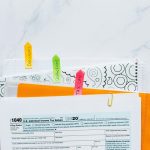You can deduct certain costs for meals and snacks consumed in your home office, but only if they’re directly related to business activities. Typically, client meals qualify for a 50% deduction, while personal snacks aren’t usually deductible. You’ll need to keep detailed records, including receipts and the purpose of each expense. To guarantee you maximize your deductions and meet all IRS guidelines, there’s a lot more to understand about eligible expenses and documentation.
Table of Contents
Key Takeaways
- Coffee costs are generally not deductible unless part of a business meeting or event.
- Snacks consumed while working are usually not deductible without a clear business purpose.
- Meals can be deducted if they directly relate to business activities, typically at 50% of the cost.
- Keep detailed records of all meal and snack expenses, including receipts and documentation of purpose.
- Consult a tax professional to better understand deductible expenses and maximize your home office deductions.
Understanding IRS Guidelines for Home Office Deductions
When you’re considering deducting home office snacks and meals, it’s essential to understand the IRS guidelines that govern these deductions.
The IRS typically allows deductions for meals and snacks only if they’re directly related to your work. This means the expenses must be necessary and ordinary for your business.
Deductions for meals and snacks are permitted only if they are necessary and ordinary for your business.
Additionally, you should keep accurate records of what you purchased and how they relate to your work tasks.
It’s also important to note that lavish or extravagant meals won’t qualify. The IRS often expects that these snacks and meals be consumed during business hours.
Familiarizing yourself with these guidelines guarantees you stay compliant and maximize your deductions effectively.
Always consult a tax professional for personalized advice.
What Expenses Are Eligible for Deduction?
When it comes to deducting meal expenses for your home office, you’ll want to know which costs qualify.
You need to distinguish between business-related meals and personal ones to maximize your deductions.
Let’s explore what expenses you can actually claim.
Home Office Meal Expenses
If you work from home, you might wonder which meal expenses you can deduct on your taxes. To qualify, your meals need to be directly related to your business activities.
If you take a client out for lunch or dinner, you can typically deduct 50% of those expenses. However, snacks or coffee you consume while working in your home office aren’t generally deductible unless they’re part of a business meeting or event.
Keep in mind that the IRS looks for a clear connection between the meal and your business, so maintain good records. Documenting receipts and noting the purpose of the meal can help you support your deduction claims come tax time.
Business vs. Personal Use
Determining which expenses qualify as business-related versus personal can be tricky, especially when it comes to meals and snacks.
To help you navigate this, here are three key points to take into account:
- Direct Business Use: If you provide snacks or meals for clients or employees during meetings, these expenses are typically deductible.
- Convenience and Necessity: If you’re working long hours and need coffee or snacks to stay productive, you may be able to deduct those costs, but keep your records clear.
- Home Office Proportion: If you consume meals in your dedicated home office space, you might claim a portion of those expenses, but only if they’re directly related to your work.
Always save your receipts and document your rationale for deductions!
The Difference Between Meals and Snacks
Most people enjoy a variety of foods throughout the day, and understanding the difference between meals and snacks can help you make informed choices for your home office deductions.
Meals typically consist of larger portions and are meant to satisfy hunger for a longer period. They often include multiple food groups, like protein, vegetables, and grains.
On the other hand, snacks are smaller, lighter options that you consume between meals to maintain energy and curb hunger. Snacks might include items like fruit, nuts, or yogurt.
Knowing this distinction is essential because it influences how you categorize your expenses when claiming deductions.
When Are Meals Considered Deductible?
To determine when meals are deductible, you need to understand the criteria for home office deductions.
It’s vital to distinguish between business meals and personal meals, as only the former qualifies.
Additionally, proper documentation of your meal expenses is essential to support your deductions.
Home Office Deduction Criteria
While working from home, knowing when meals and snacks can be deducted is essential for maximizing your tax benefits.
To qualify for a deduction, verify your meals meet these criteria:
- Business Purpose: The meal must be directly related to your business activities or client meetings.
- Documentation: Keep detailed records, including receipts and notes about the purpose of the meal.
- 50% Limitation: Generally, you can only deduct 50% of the cost of business meals, so be mindful of this when calculating your deductions.
Business vs. Personal Meals
Determining whether a meal is deductible hinges on its connection to your business activities. If you’re entertaining clients, attending a business conference, or traveling for work, those meals can qualify as deductible expenses.
On the other hand, meals consumed at home while you’re simply working or taking a break generally aren’t deductible. To make the most of meal deductions, focus on situations where your meal serves a clear business purpose.
For instance, if you’re meeting a colleague to discuss a project over lunch, that meal is likely deductible. However, if you’re just grabbing a bite during your work-from-home hours without any business context, it won’t qualify.
Keep the purpose of the meal front and center to determine deductibility.
Documenting Meal Expenses
When you’re looking to deduct meal expenses, it’s essential to keep thorough records that clearly show the business purpose behind each meal.
To guarantee your deductions hold up during an audit, consider these three key documentation tips:
- Date and Time: Record when each meal took place, as this helps establish its relevance to your business activities.
- Attendees: Note who was present, especially if they’re clients or business partners, to demonstrate the meal’s business nature.
- Purpose: Write down the reason for the meal, such as discussing a project or negotiating a contract, to clarify its business intent.
Documenting Your Expenses Properly
Properly documenting your expenses is essential for maximizing deductions on home office snacks and meals. Start by keeping detailed records of each purchase.
Make certain to save receipts and note the date, amount, and purpose of every transaction. A dedicated expense log or spreadsheet can help you organize this information easily.
If you purchase snacks and meals for business meetings or client visits, clearly indicate these occasions in your records. Be specific about the items consumed and their connection to your work.
Regularly review your documentation to guarantee it’s accurate and complete before tax season. This diligence won’t only support your deductions but also simplify your filing process, making tax time less stressful.
The 50% Rule for Meal Deductions
Understanding the guidelines for meal deductions is essential once you’ve documented your expenses correctly.
The 50% rule states that you can only deduct half of your meal costs when dining out or ordering in for business purposes. Here’s what you need to know:
The 50% rule allows you to deduct half of your meal costs for business-related dining expenses.
- Business Purpose: Make certain the meal is directly related to your business activities—networking, client meetings, or work-related meals.
- Document Expenses: Keep receipts and note the purpose, date, and attendees of each meal to substantiate your claims.
- Limitations: This rule applies to meals, not snacks or coffee; those are generally not deductible unless they meet specific criteria.
Common Misconceptions About Home Office Deductions
What do you really know about home office deductions? Many people mistakenly believe that any expense related to their home office is fully deductible. In reality, only specific costs qualify.
For example, you can’t deduct the full cost of your morning coffee unless you meet certain criteria. Another common misconception is that you can claim meals and snacks consumed at home, but this isn’t as straightforward. You must substantiate the business purpose behind these expenses.
Additionally, some think they can claim a portion of their home utilities, but that’s only applicable if you use a dedicated area for your office. Understanding these misconceptions can help you navigate the rules and maximize your deductions more effectively.
Tips for Maximizing Your Deductions
How can you guarantee you’re taking full advantage of your home office deductions? Start by keeping meticulous records of all your expenses.
Here are some tips to help you maximize your deductions:
- Document Everything: Track meals, snacks, and beverages consumed during work hours with receipts and notes on the purpose of each item.
- Use a Dedicated Workspace: Ascertain your home office is a separate area. This strengthens your case for deductions related to meals and snacks.
- Understand Deduction Limits: Familiarize yourself with IRS guidelines on meal deductions, as you can typically deduct only 50% of qualifying expenses.
Consulting a Tax Professional for Personalized Advice
While you may feel confident managing your own home office deductions, consulting a tax professional can provide tailored insights that guarantee you’re maximizing your benefits. They’ll help clarify what’s deductible, ensuring you don’t miss out on potential savings. Here’s a quick guide to evaluate when choosing a tax professional:
| Criteria | Importance | Questions to Ask |
|---|---|---|
| Experience | Knowledge of tax laws | How long have you been practicing? |
| Specialization | Specific deductions | Do you focus on home office cases? |
| Availability | Ongoing support | How accessible are you year-round? |
| Fees | Budget considerations | What’s your fee structure? |
| Reviews | Trustworthiness | Can you provide client references? |
Taking the time to consult an expert can lead to significant financial advantages.
Frequently Asked Questions
Can I Deduct Coffee Purchased for Clients in My Home Office?
You can generally deduct coffee purchased for clients if it’s directly related to your business activities. Keep detailed records of expenses, ensuring they meet IRS guidelines for business meal deductions. Consult a tax professional for specifics.
Are There Limits on the Amount I Can Deduct for Snacks?
Yes, there are limits on the amount you can deduct for snacks. Generally, you can only deduct 50% of the cost if it’s directly related to business activities. Keep accurate records to support your deductions.
Can Home-Cooked Meals Be Deducted if Consumed During Work Hours?
You can’t deduct home-cooked meals simply because you eat them during work hours. The IRS generally requires meals to be business-related or incurred while traveling for work to qualify for deductions.
What if I Order Takeout While Working From Home?
Ever thought about how ordering takeout during work hours feels? If you’re working from home, you can’t deduct those costs unless they’re directly related to business meetings or client meals. Keep that in mind!
Do I Need Receipts for Every Coffee or Snack Purchase?
You don’t need receipts for every single coffee or snack purchase, but keeping a log of spending is smart. It helps you track expenses, making it easier to justify deductions if needed during tax time.




